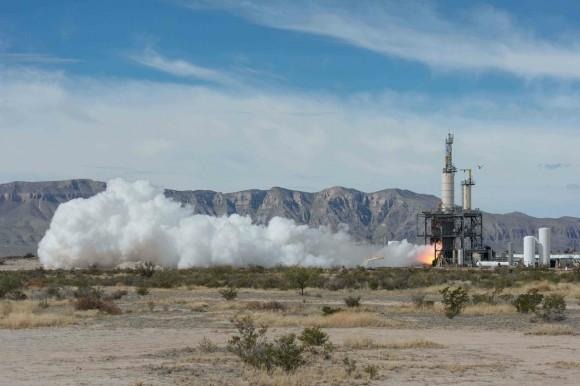Bezos' Blue Origin teases 2018 missions as it chases SpaceX
Blue Origin, the private space flight start-up funded by Amazon founder Jeff Bezos, has successfully tested off-the-shelf hydrogen rockets ahead of 2018 unmanned missions starting, though the company says it expects to switch eventually to rockets of its own design. The company, which will present its engine work to NASA in May 2014 as part of its ongoing part-funding from the US space agency, expects to also have human passengers flying – albeit suborbital – in the same timeframe, Rob Meyerson, president and program manager, told Aviation Week, as Blue Origin revealed a few extra details about what has been one of the more clandestine space projects.
Blue Origin announced it had successfully tested the BE-3 liquid hydrogen rocket engine last week, using the American-made design for a light, coasting, restart, and throttle-down run-through intended to simulate the demands that will eventually be made of it in flight. According to Meyerson, Blue Origin ran as many as 2-4 tests on the rocket per day in the nine months running up to the successful trial.
Although rival projects, such as SpaceX, are better known than Blue Origin, the company may surprise with how quickly it can ramp up to operations. A previous funding phase by NASA, CCDev-2, "allowed us to accelerate the program by about one year" Meyerson claims, with the space agency testing the BE-3 thrust chamber at the Stennis Space Center last year.
Now, in addition to experimenting with ways to lower the cost of manufacturing so as to make private space flights more cost-effective, Blue Origin is looking at ways that it could design its own engines. According to Meyerson, the final design may build on the BE-3, or it could well use a homegrown design that the company is still kicking around internally.
"Some things are in development for other engines that we're developing, but we're not ready to discuss those today" the project director teased. "Those would provide other options and other architectures."

Blue Origin was founded back in 2000, but has grown considerably since the ten person team then, Meyerson says. Now, it employes around 300, with plans to add as many as 100 more to that list, as it ramps up for unmanned and then manned flight.
One of the company's time-saving strategies, Meyerson says, has been making greater use of computer modeling, which supposedly allowed for a fully-functional turbopumb design to be prototyped on its very first trial. The engines under trial will also have applications for other government and commercial launch options too, he points out.
